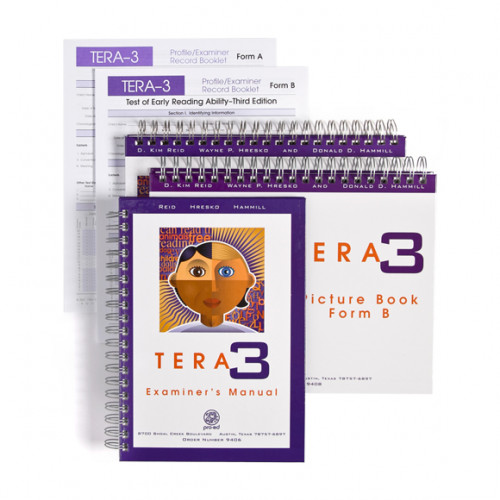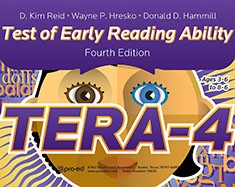*DISCONTINUED (*NEW EDITION in Alternatives below)
The Test of Early Reading Ability-Third Edition (TERA-3) is a unique, direct measure of the reading ability of young children ages 3-6 through 8-6. Rather than assessing children's "readiness" for reading, the TERA-3 assesses their mastery of early developing reading skills. This new edition has been redesigned to provide the examiner with three subtests: Alphabet (measuring knowledge of the alphabet and its uses), Conventions (measuring knowledge of the conventions of print), and Meaning (measuring the construction of meaning from print). Standard scores are provided for each subtest. An overall Reading Quotient is computed using all three subtest scores.
The TERA-3 has been improved in the following ways:
1. All new normative data were collected during 1999 and 2000.
2. Characteristics of the normative sample (n = 875) relative to socioeconomic factors, gender, disability, and other critical demographics are the same as those projected by the U.S. Bureau of the Census for 2000 and are representative of the current U.S. population.
3. The normative information is stratified by age relative to geography, gender, race, residence, and ethnicity.
4. Studies showing the absence of gender, racial, disability, and ethnic bias have been added.
5. Reliability coefficients have been computed for subgroups of the normative sample (e.g., African Americans, Hispanic Americans, females) as well as for the entire normative sample. Reliability is consistently high across all three types of reliability studied. All but 2 of the 32 coefficients reported approach or exceed .90.
6. New validity studies have been conducted; special attention has been devoted to showing that the test is valid for a wide variety of subgroups as well as for a general population.
7. New items have been added to make the test more reliable and valid for the upper and lower ages covered by the test.
8. All pictures have been drawn in color to present a more appealing look to children.
9. Examiners no longer have to prepare their own items that require the use of company logos and labels because these items are now standardized and provided as part of the test kit. Logos and labels from such national companies as McDonald's, and Kraft, Libby's, are used to make the TERA-3 colorful and meaningful.
10. Age and grade equivalents are provided.

 Proud to be Canadian
Proud to be Canadian
